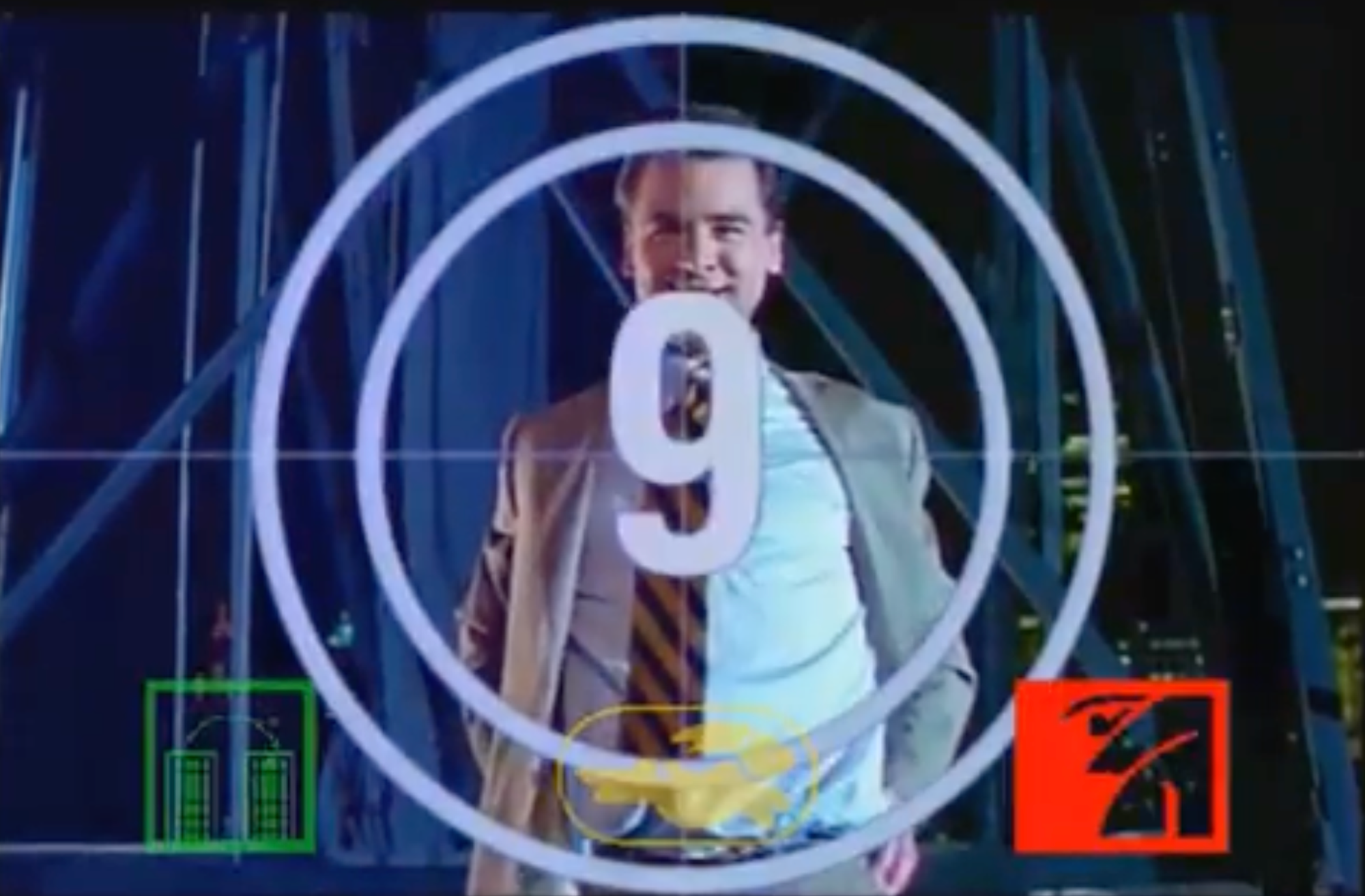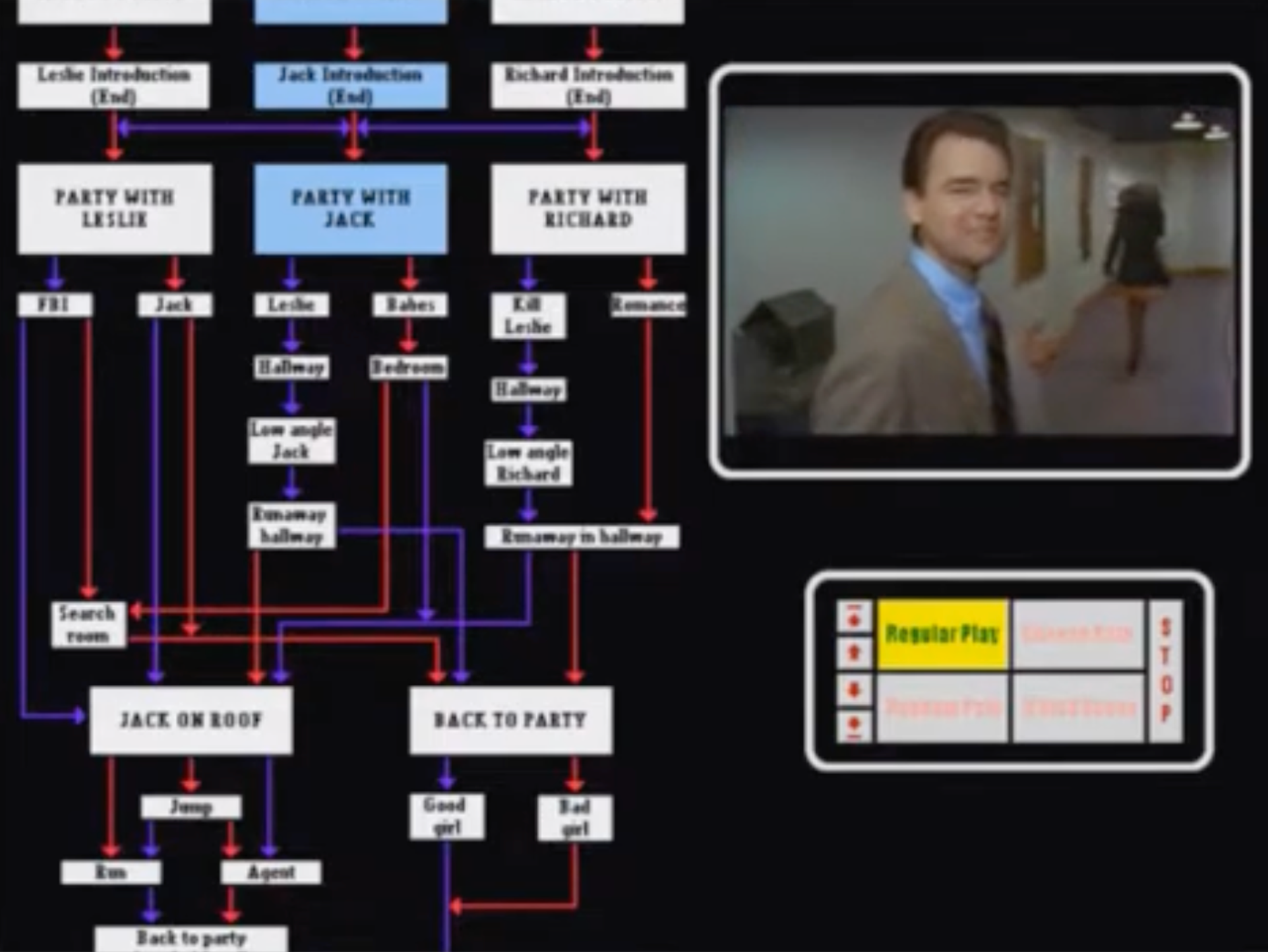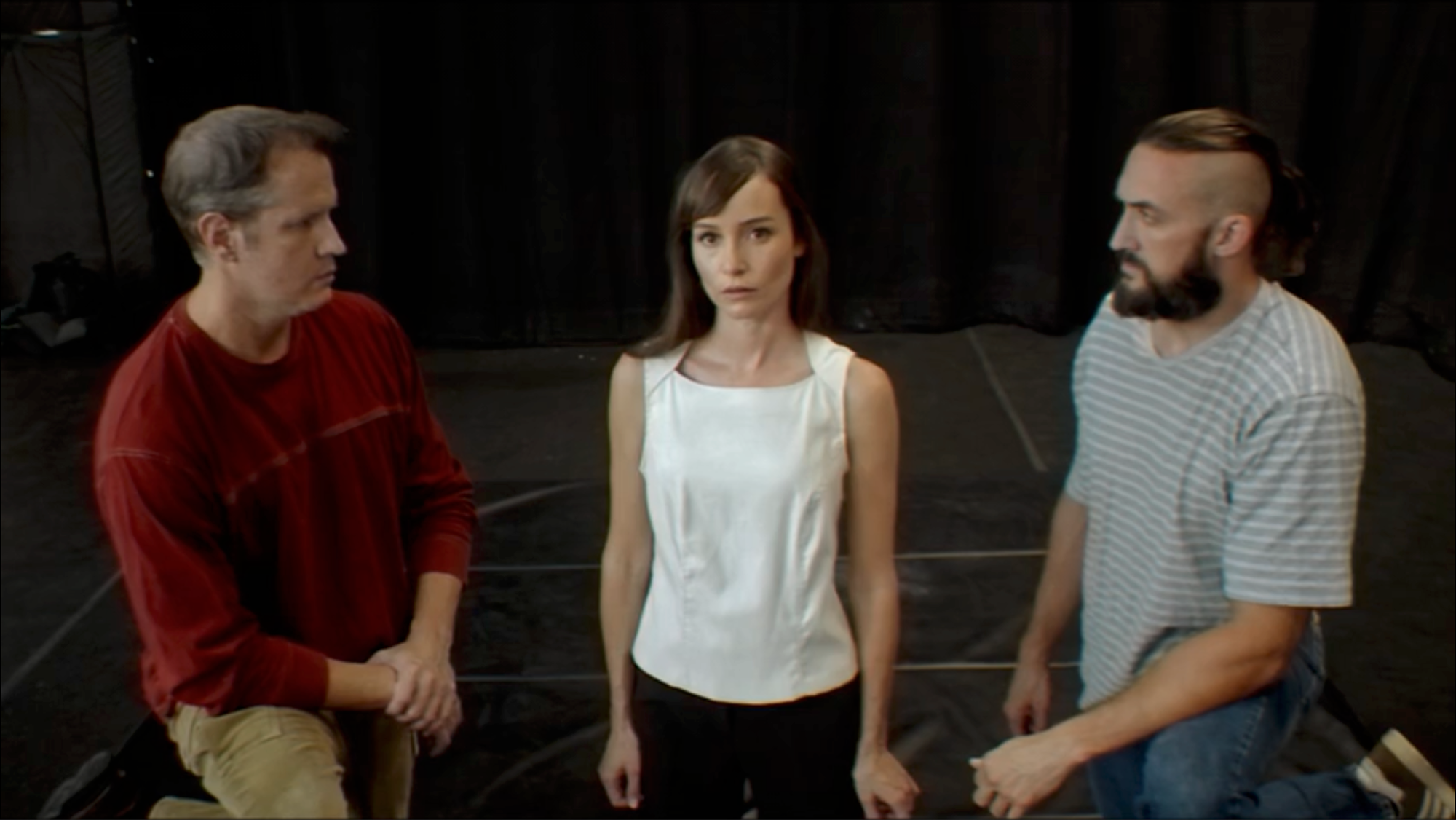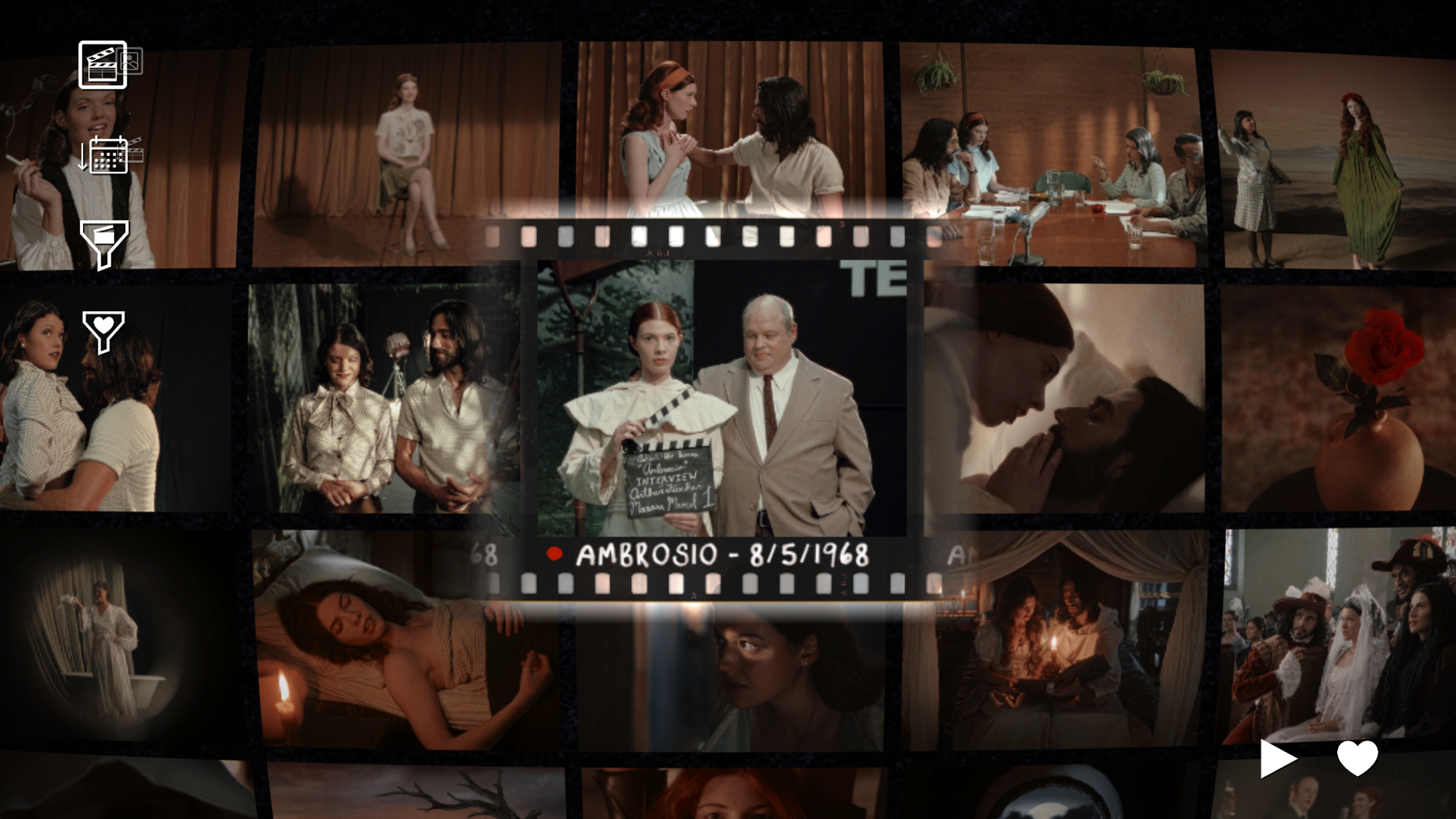Playing God
Jenny Odell, Lost at Interface, 2017.
Courtesy of the artist.Jack’s stranded on the roof of a warehouse. He’s in a pickle. His date has disappeared. Downstairs, a bomb-wielding madman in a sharp suit is looking for him, and someone’s just cocked a gun to his temple. But Jack is unflappable. He smiles, and turns to the camera, eyes twinkling. “My first instinct is to run like a scared rabbit, because that’s my nature,” he admits. But Jack has other options. He could leapfrog off the roof to an adjoining building, for example. Or reveal his true identity as Special Agent Jack Beaner, of the FBI. He looks at us expectantly: his fate is in our hands.
Or it would be—if it were 1992, and I was at the Loews Cineplex on 19th Street in New York City, watching I’m Your Man, the first mainstream interactive movie. In that case, I could just grab the controller attached to my armrest, and press a button. Yellow for run away, green for jump off the roof, and red for Special Agent Jack Beaner. A control system would tally my vote, along with everyone else’s, and play the most popular selection. For my $7 ticket price, I could watch three of the 68 possible variations of the movie in a row. But, of course, it isn’t 1992 anymore.
It’s 2023, and I’m watching I’m Your Man on a folding chair in the packed screening room of Whammy Analog Media, a VHS tape store and microcinema in Echo Park.
There are no controllers in the armrests here, so the audience is just hollering at the screen: RUN! JUMP! SPECIAL AGENT JACK BEANER! It’s part of a program of forgotten interactive films, all artifacts of a brief period in the 1990s when it seemed like Silicon Valley and Hollywood might actually become one.
In Hollywired—or would it be Silliwood?—audiences would play the director, molding the on-screen action to suit their fancy. If the atmosphere at this screening is any indication, it was a raucous, fun time, so long as you didn't really care about movies.
*
I’m Your Man was the brainchild of Bob Bejan, a former ad guy who cut his teeth writing “industrial” musicals—huge productions, often stacked with Broadway talent, staged at trade shows and annual corporate meetings. Bejan wrote I’m Your Man in two weeks and shot it in six days for $307,000 in the Soho offices of his production company, Interfilm. His collaborators, mostly New York theater people with improv backgrounds, laid each plot beat on the ground and walked the forking storyline paths, acting out what each character might do at key points in the narrative. The final shooting scripts were structured like a Choose Your Own Adventure book, dotted with programmatic cues.
It was, to say the least, a new way of making movies. On set, the First Assistant Director had a meltdown, convinced nothing was going to cut together, and the film’s lead, a former MTV Video Jockey named Kevin Seal, joked that he could barely keep track of the story. But I’m Your Man came together, and in theaters updated with LaserDisc control systems, the film “exploded,” Bejar tells me. “It was just one of those things, a freak thing—it just worked.” At screenings, college kids in lab coats riled up audiences, encouraging them to yell and press each other's buttons. Teens loved the pandemonium so much that they didn’t even notice the degraded quality of the early digital projection compared to film.
Critics were less generous. Having “endured” six repeat screenings of I’m Your Man at a megaplex in Lakewood, California, the LA Times’ Peter Rainer concluded that the format resembled a high-school pep rally more than it did a movie, the unfortunate result of test-marketing eating art. “The spooky thing about I’m Your Man,” he wrote, “isn’t how different it is from Hollywood movies but how much the same it is.” As if to prove Rainer’s point, Sony Pictures gave Interfilm a five-picture deal and a bungalow on the studio lot. They committed 100 screens at Loews Theaters across the country to be retrofitted with pistol grips and digital projectors, to the tune of some $87,000 per room. The following year, Interfilm went public and raised $25 million.
It was the dawn of the tech bubble, but Bejan was certain they were onto something. “We thought of ourselves—well, we probably thought too much of ourselves,” he concedes. “But we thought of ourselves as squarely rooted with one foot in cinema and one foot in gaming.” Two generations of movie-watchers had grown up with controllers by then, and video games were about to eclipse the movie business in sales for the first time. Why couldn’t audiences have it both ways? Why not play the movie? Five-time GRAMMY nominee Joe Jackson, who composed I’m Your Man’s original score, put it best. “Whenever you get an opportunity to be involved in something new, you might as well be in on it,” he said. “Even if it goes the way of 3D glasses and Odorama.”
Interfilm would go on to shoot four more interactive movie-games. The second, Mr. Payback, written by Back to the Future’s Bob Gale, starred soap star Billy Warlock as a bionic man who disciplines jerks: audiences could make Mr. Payback force an executive to eat from a dog dish full of monkey brains, for example. As with I’m Your Man, a ticket to Mr. Payback included repeat viewings of the movie, so audiences could try alternative punishments—although film critic Gene Siskel, of Siskel & Ebert, swore on their show he’d have paid twice as much to see it only once. “This is not a movie,” Ebert, who would later name Mr. Payback the worst film of 1995, agreed. “A movie acts on you.”
Following Ebert’s logic, if a movie is meant to act on its audience, then a game is the inverse: an invitation for the audience to act. Of course, within the confines of a “game” like Mr. Payback or I’m Your Man, that invitation is limited to predetermined decision points. But even in the more open sandbox of a modern video game, there are boundaries on action—in fact, those boundaries are what define the form. As the games scholar C. Thi Nguyen observes, all games have rules and obstacles, imposed to constrain player agency. And games are, he argues, the art of agency. “As stories let us record narratives,” Nguyen writes, “games let us record agencies,” encoding them into “artifactual vessels” that can be passed around and temporarily embodied by others.
I’m not sure what that means for an interactive movie like I’m Your Man. Despite offering plenty of freewheeling fun, it hardly feels like an expression of the art of agency—unless the agency being explored is that of an indecisive film editor. I have the sense that Ebert’s curmudgeonly take was the right one: an interactive movie is not a movie. But it isn’t a game, either. It’s somewhere in between the two, and its precise location on the spectrum shifts with the decades. Although it never seems to succeed commercially, a few weirdos in every generation give it a try.
I should know; I’m one of them.
*
In the ’90s, I’m Your Man was billed as the world’s first interactive movie. But that wasn’t exactly true. “Let me tell you, it goes back—all the way, nearly, to the beginning of film,” explains Stephen Padmore, a developer who has been tracking the interactivity of games and cinema on his website, FMVWorld.com, for nearly 20 years.
A century to the year before the release of I’m Your Man, European merrymakers could shoot live rounds in “cinematic shooting galleries," killing safari animals projected on a paper screen. This concept survived into the 1970s; Nintendo’s first arcade game, Wild Gunman, played back live-action gunslinging sequences on dual 16mm projectors. Film gave way to LaserDisc in the 1980s, which is when a 12-year-old Padmore discovered the interactive cartoon Western Badlands in his local arcade. “It was the most beautiful thing I'd ever seen,” he says. “I was just thinking to myself, this is it. I was convinced the combination of video games and movies was the future of entertainment.”

Still from I'm Your Man, 1992.

Still from I'm Your Man, 1992.

Still from I'm Your Man, 1992.
For the next decade or so, that future looked bright. Interactivity bounced from arcades to home media in the ’90s, with “Full Motion Video” games that took advantage of the storage capacity of CD-ROM to layer live-action video clips over computer-generated worlds. These FMV games often featured top Hollywood talent, like Mark Hamill and Malcolm McDowell, who played twenty-seventh-century fighter pilots in Wing Commander III, or Tim Curry, who played Dr. Frankenstein in a Sega Saturn game. Even the great Burgess Meredith’s final performance was on CD-ROM—in Ripper, a detective slasher also starring Christopher Walken. In 1995, I’m Your Man creator Bob Bejan was poached by Warner Brothers, which was joining other major movie studios in spinning out interactive divisions to “repurpose” their “assets” for these novel formats.
But Hollywood’s attempts to shoehorn cutting-room-floor scraps into interactive games led to a number of high-profile flops, like a much-maligned Lawnmower Man FMV. By the late 2000s, the general consensus, according to game designer James Lessard, was that “mixing video games and cinema can only lead to a product that is both a bad movie and a bad game.” FMVs became a punchline in both industries, and game designers began to opt for pre-rendered CGI cutscenes instead, frustrated by the cost and production expertise required to shoot live-action sequences. The dream, it seemed, was dead.
Padmore is still waiting on the future he glimpsed at the arcade in the ’80s. “But we're closer now than we've ever been,” he promises. He should know; his archival website isn’t so archival anymore. Since about 2014, he’s seen a steady clip of new interactive releases, largely made by filmmakers who have never played an FMV, or seen oddities like I’m Your Man. “There's something in human nature, where people watch a movie, they don’t like the outcome, and they say, you know what? I'm gonna make a movie where you get to decide,” he says. “And that happens with every single generation.”
These generation cycles tend to follow technology. Interactive media, having exhausted the possibilities of film, LaserDisc, CD-ROM, and DVD, made a leap to streaming platforms in the 2010s with projects like Netflix’s Black Mirror: Bandersnatch and Stephen Soderbergh’s 2017 iOS app, Mosaic, for HBO. Although these weren’t particularly successful—Netflix has since pulled all of its interactive titles—the dance between games and cinema isn’t over yet. Actors have returned to games, only now they perform in motion-capture suits, and game engines like Unreal Engine have become integral to Hollywood’s visual effects toolkit. Those old crunchy FMVs aren’t cringe anymore; they’re a vibe. And a new generation of game designers, inspired by auteur filmmaking and empowered by distribution platforms like Steam, has begun to reinvent the FMV.
“What's happening now is the tools are not in the way,” says Bob Bejan, who hasn’t quite given up on the dream, either. “Back in the ’90s, we spent a disproportionate amount of time trying to overcome the technical challenges instead of really thinking about storyline and characters, and compelling narrative. Now, for the first time, it feels like we're at the precipice of this thing really breaking through.”
I hope so. I started researching this piece in 2023 for my own reasons. Talking with Padmore and Bejan, I was quietly banking my findings for later reference—my friends and I were working on an FMV project of our own. Like I’m Your Man or Mr. Payback, it would live in the forbidden zone between movies and games; like the FMVs of the ’90s, it would try to wrangle live-action performances onto console and PC screens. I was hoping a deep dive into the history of interactive movies would give me some ideas—about what to avoid, what to attempt, and what we were getting ourselves into.
But there’s a difference between writing about games and actually writing one yourself. As I started working, I quickly realized that there was something about the format that I couldn’t square with my own narrative goals. In traditional FMVs, the player is the protagonist—they’re the one with their finger on the button that decides “yes/no, left/right, fight or flight,” as Padmore put it to me. For the player, that’s a laugh. But for the writer, crafting a compelling, one-size-fits-all main character is a real challenge. It’s an empty crater at the center of the story: when Special Agent Jack Beaner looks at the camera, who does he see? Is it a confessional? Is it Brechtian theater? Am I God?
From the vantage point of 2025, these questions feel eerily, almost unpleasantly familiar. After all, social media feeds are dominated by performers speaking to camera: pundits, personalities, and conspiracy-peddlers who weave narratives from the news, nudging their audiences to “solve” the puzzle of reality. They address us directly, asking for engagement, for us to like and subscribe to keep the story going. Everything feels like a game; everyone thinks they’re the main character; maybe the whole world is an FMV now. This fundamentally changes the stakes—to say nothing of the possibilities—of an interactive cinema. Which is why I turned, at last, to Sam Barlow.
*
Barlow is a BAFTA-winning game designer; his three titles have done more to develop a grammar of interactive media than anything else in the last 30 years. “A big frustration of mine is the reduction of video games to being a more childish form of roleplay,” he told me, when we spoke over Zoom. “The stories I like are the ones that are more layered, that have unreliable narrators, or interesting framings, or push you to try and identify with characters in interesting ways. Even when I was making more traditional-looking video games, I had a little Post-it on my desk that said ‘The player is not the protagonist.’”
Instead, they’re what they’ve always been: a lurker, watching from just outside the narrative frame. In Barlow’s game Telling Lies, for example, the player is an unseen NSA whistleblower assembling a dossier on a group of ecoterrorists from leaked surveillance footage; in Her Story, they're crawling a police database, looking for truth in hours of unreliable witness testimony. In Immortality, which premiered at the 2022 Tribeca Film Festival, the player is an editor—and the subject is cinema itself.

A still from Sam Barlow's Immortality, 2022.

A still from Sam Barlow's Immortality, 2022.

Still from Bob Barlow's Immortality, 2022.
The objective of Immortality is to restore three “lost” films, each of which Barlow and his team fully scripted and shot on a soundstage in Los Angeles. Immortality’s central mechanic is an old-fashioned editing moviola: as they watch, rewind, and rewatch hundreds of takes, the player-editor follows match-cuts across the decades, daisy-chaining from the tail end of the studio system to ’70s New Hollywood and eventually ’90s independent cinema. In each clip, actors vamp, and in the background, camera assistants make adjustments, costumers tweak bodices, PAs fetch coffee—all clues to piece together the supernatural drama happening behind the scenes.
Although they’re usually classified as FMVs, Barlow’s games are not the choose-your-own-adventure type. In interviews, he sometimes compares them to sculptures: while players may look at them from different angles, they’re all looking at the same thing. In my own experience of playing Barlow’s games, the analogy feels apt. Navigating his corpora of footage, I always have the sense that there’s something ominous hidden beneath the screen, like an ancient statue on the ocean floor belying still waters at the surface. “Sam is in a category of his own,” says Padmore, reverently.
Rather than writing branching narratives, Barlow sculpts a programmatic logic that surfaces plot points at key moments in the viewer’s otherwise self-directed exploration. As the player progresses along the footage, the game engine stages unexpected reveals, until a hidden meta-story emerges. “Not to invoke a word that is now evil, but I bring an algorithmic mentality to things,” he explains. “I structure and write stories that are big masses of stuff, and then I assign values to that stuff, coming up with a game mechanic that gives the player the ability to explore. The key is that the player's exploration can be intentional, and can have structure to it, as well as being surprising.”
In a 2023 keynote talk the morning after Immortality won a major game award, Barlow cited Nicholas Roeg’s freeze frames, the failed projects of Orson Welles, and Rita Hayworth’s hair. He called Eyes Wide Shut his “North Star” and professed that he was trying to create the Citizen Kane of video games. When we spoke later that year, he name-dropped Peter Greenaway, Brian De Palma, and Alfred Hitchcock. All to say, although his films could never play in theaters, he’s a massive film geek—and although the games world gives him plenty of latitude and comes with a built-in audience, he doesn’t quite fit in there, either.
Barlow’s first job out of college was working for a tech company. His “proto-Elon Musk” boss ran new hires through a six-week database bootcamp, tasking them with sifting through sales data to find useful correlations: dads picking up six-packs on their diaper runs, for example. “As a fan of surrealism and found stories, I was exploring all this weird data about people's purchasing habits and being like, ‘oh, there's a story there,’” he remembers. “I was sucking narrative out of all these random arrangements of stuff.”
He moved to games semi-accidentally after the dotcom crash, first as an artist and then as a writer and director of games like Silent Hill: Shattered Memories. By the time he made the leap to producing his own indies with the breakout Her Story in 2015, he’d already spent years working with voice actors and directing motion-capture cinematics. The game was an unexpected hit, selling over 100,000 copies and nearly single-handedly reviving the maligned FMV genre. When Barlow made Telling Lies in 2019, he had a real production budget, a full film crew, and actors like Logan Marshall-Green from Prometheus and Halt and Catch Fire’s Kerry Bishé. “I realized all these people are extremely good at their jobs,” he said, “but none of them know what this thing is that we’re making.”
This is pretty much what Bob Bejan told me about filming I’m Your Man: that the writers, film crew, and actors were all figuring it out as they went along. I guess that’s just what it is to work in a new medium. And interactive movies, despite their surprisingly long history, remain persistently new, seeming eternally around the corner. Maybe that’s okay. Maybe it’s even a good thing. If there’s no right way to make an FMV, there’s no wrong one, either. Anything is still possible.
When we spoke, Barlow told me about how the Polish filmmaker Krzysztof Kieślowski, while editing The Double Life of Veronique, begged his producers to let him release 20 different cuts of his film. How could a director possibly choose one take over another? How could they definitively decide how it all comes together? All movies are shot out of sequence. At the end of production, a movie is just footage on hard drives. Linearity comes later, in the edit bay—or at the moviola. As the new media theorist Lev Manovich famously observed, it’s the editor’s job to trace “a unique trajectory through the conceptual space of all possible films which could have been constructed.”
The finished movie represents just one potential trajectory, but there are others: the studio cut, the director’s cut, the censored version for airplanes, the fan edit, and all the other sequences never made. Until the moment the edit is locked, a film could be all of those things. It could be anything. Seen this way, a movie is not so different from a game.
But then again, neither is life. ♦
Subscribe to Broadcast